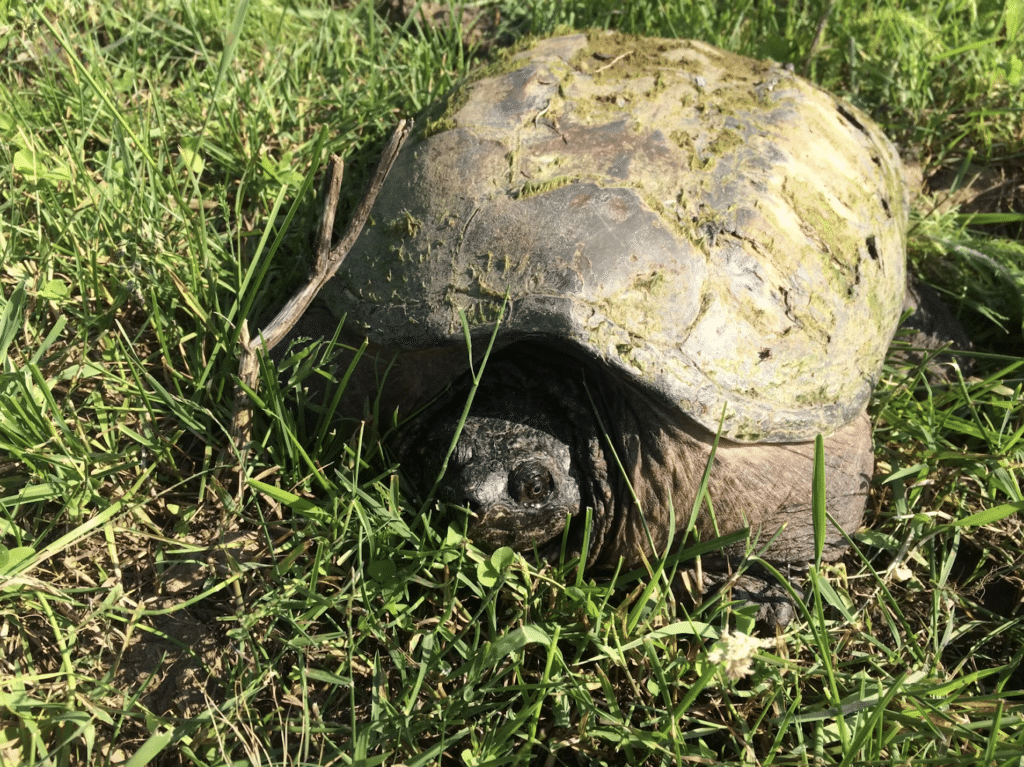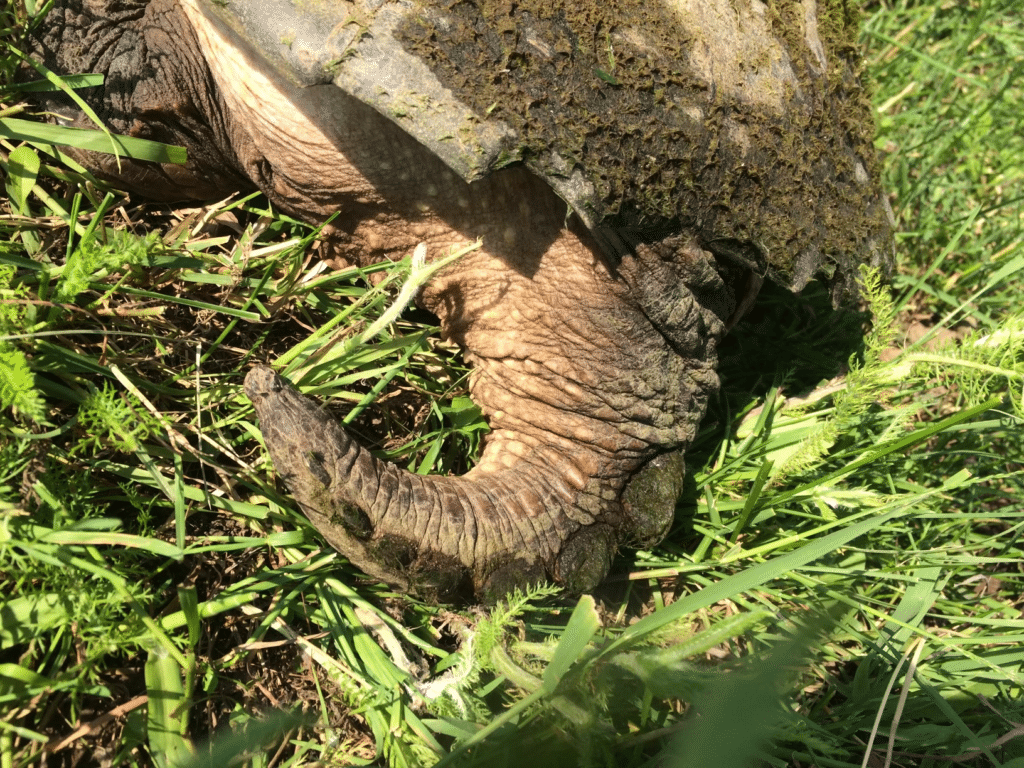
Often found with its dome dramatically draped in algae and vegetation, the Snapping Turtle isn’t just making a snappy fashion statement! These incredible creatures can live to be over 100 years old, and they deserve our respect and protection.
Like other turtles, Snappers are well known in Indigenous cultures. In the Ojibwe language, the snapping turtle is called “miskwaadesi” (pronounced miss-kwa-daze-ee). In the Mohawk language it is known as “kenhionnió:ron” (pronounced ken-ee-yo-nee-o-ron).
Snapping Turtles enjoy a diet of just about anything they can catch! Creatures like frogs, small birds, insects, small mammals, other smaller turtles, and even carrion are all fair game to a Snapper. You can find these feisty turtles all over the FAB region in ponds, swamps, lakes and rivers. The safer their habitat, the larger they have the chance to grow.
If there is a wetland area in the FAB region that you frequent, and you often spot a Snapping Turtle, pay close attention each year to see if it’s the same one. A scientist has been tracking the same female in Algonquin Park for over 40 years, and estimates that it may be over 100 years old!
You know you are looking at a Snapping Turtle if you spot their large, bulky dark brown shell (called a carapace) that is frequently sporting a good deal of vegetative growth. The older the turtle, the larger the shell and the more growth you will see. Snapping turtles have sturdy, triangular shaped heads with a hooked beak. It has a long neck that can move incredibly fast, and strong jaws that can clamp down in an instant.

Something many people don’t know about Snapping turtles is that they have a very unique way of breathing underwater. They have the ability to extract oxygen from the water through their cloaca. A cloaca is a multi-purpose opening used for waste elimination, reproduction, and respiration. So, the next time a kid tells you turtles can breathe through their butts, they aren’t wrong.
The Snapping Turtle is considered an apex predator, although they do have a few natural predators. Their eggs are of course very vulnerable to prey, and from time to time larger birds and animals like eagles, osprey, bobcats, and coyotes might decide to dine on a Snapper.
The biggest threat to Snapping Turtles is the things we humans do. As we encroach on their habitat, and our roads get more traffic, the turtles are at risk of dying before reaching breeding age. A Snapping Turtle isn’t able to breed until it reaches about 10 years of age. Many of the turtles are killed on roadways before they can start a new generation of offspring.
How can you help protect Snapping Turtles?
Due to their Species at Risk Status, it’s important that one be cautious and respectful when you encounter them in nature.
The Ontario Ministry of the Environment, Conservation, and Parks gives us the following guidelines to help this important turtle species:
Report a Sighting

- the Ministry of Natural Resources and Forestry tracks species at risk; you can use a handy online form to report your sightings to the Natural Heritage Information Centre; photographs with specific locations or mapping coordinates are always helpful
- every year, turtles all over the province cross busy roads to get to their nesting sites, or use gravel shoulders of roads as nesting sites; watch for turtles on the roads, especially between May and October
- the Ontario Reptile and Amphibian Atlas also collects observations of all Ontario reptiles and amphibians. Submit your observations at: www.ontarionature.org/atlas.
Volunteer
Volunteer with your local nature club or provincial park to participate in surveys or stewardship work focused on species at risk.
Be a good steward
- private land owners have a very important role to play in species recovery; you may be eligible for stewardship programs that support the protection and recovery of species at risk and their habitats
- For farmers that have wetlands on their property, it’s important to fence riparian areas off from livestock. There are grants available to help with these costs.
- as with many other rare plants and animals, the Snapping Turtle depends on wetland habitat; you can help by protecting any wetlands and surrounding natural vegetation on your property
- visit the Ontario Reptile and Amphibian Atlas (www.ontarionature.org/atlas) or Toronto Zoo Adopt-a-Pond website (www.torontozoo.com/Adoptapond) to learn more about Ontario’s turtles.
Report illegal activity
Report any illegal activity related to plants and wildlife to 1-877-TIPS-MNR (847-7667).
Quick stats:
Scientific name: Chelydra serpentina
Status: Species at Risk, Special Concern
Description: Canada’s largest freshwater turtle, they can grow to 20-36 cm and up to 16kg. They have large black, olive or brown shells usually covered in algae. Their tails, which can be longer than their bodies, have dinosaur-like triangular crests along their length. Hatchlings are about the size of a loonie and are smaller and darker than adults, with pronounced ridges along the length of their shell.
Habitat: Snapping Turtles spend most of their lives in water, preferably shallow waters where they hide under the soft mud and leaf litter, with only their noses exposed to the surface to breathe. During the nesting season, from early to mid summer, females travel overland in search of a suitable nesting site, usually gravelly or sandy areas along streams. Snapping Turtles often take advantage of man-made structures for nest sites, including roads (especially gravel shoulders), dams and aggregate pits.
Location: Snapping Turtles can be found in massive area across North America. Their range stretches from Ecuador to Canada. In Canada this turtle can be found from the prairies to Nova Scotia, but it is primarily limited to the southern part of Ontario. As the best habitat sites are encroached on, the Snapping Turtle’s range is shrinking..
Another species in the FAB region that lives near turtles are salamanders. They are also on the Species at Risk list, and an important part of our ecosystem. Check out our blog post about it to learn more.





